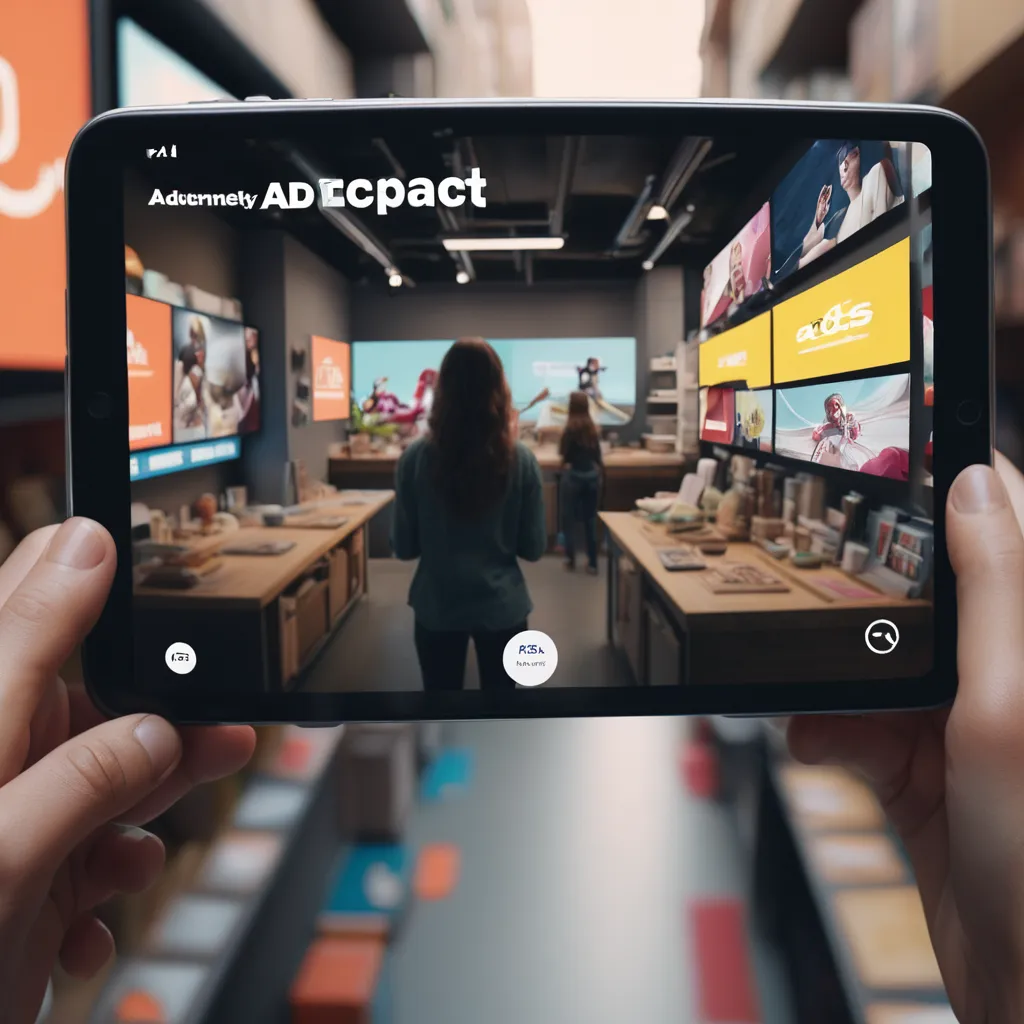Blog

Augmented Reality Advertising: Revolutionizing the Future of Marketing
Augmented Reality (AR) advertising is a cutting-edge marketing technique that blends virtual elements with the physical world, allowing consumers to interact with digital content in their immediate surroundings. Unlike traditional advertising, AR ads do not simply interrupt the user experience; instead, they seamlessly integrate digital enhancements that enhance and complement the real-world environment.
At its core, AR advertising leverages mobile devices and specialized applications to superimpose interactive 3D models, animations, or information onto the user's physical environment. This technology enables brands to create immersive, engaging experiences that capture the attention of consumers and drive meaningful interactions.
The Rise of Augmented Reality in Marketing
The adoption of Augmented Reality (AR) in the marketing industry has been steadily increasing over the past decade, driven by advancements in mobile technology, the growing popularity of smartphones, and the desire for more innovative and engaging advertising experiences.
The Watershed Moment: Snap's Spectacles and the Mainstreaming of AR
A significant milestone in the mainstream adoption of AR advertising was the release of Snap's fourth-generation Spectacles in 2021, which came equipped with AR capabilities. This marked a shift in the perception of AR, moving it from a niche technology to a more accessible and widely recognized tool for marketers. The introduction of AR-enabled Spectacles, along with the widespread use of AR filters and lenses on Snapchat, has helped to familiarize consumers with the concept of AR and paved the way for its broader integration into marketing campaigns.
The Race for AR Dominance: Tech Giants Invest Heavily
As the potential of AR in advertising becomes increasingly apparent, tech giants like Apple, Google, and Meta (formerly Facebook) have been investing heavily in the development of AR-related hardware and software. For example, Google has announced plans to test AR device prototypes, including smart glasses, in public settings, while Apple is rumored to be working on the release of an AR/VR headset and "smart glasses" in the coming years.
These investments and advancements in AR technology are driving the evolution of the marketing landscape, as brands seek to leverage the immersive and engaging nature of AR to connect with consumers in new and innovative ways.

The Benefits of Augmented Reality Advertising
Increased Engagement and Interactivity: AR ads allow consumers to interact with digital content in their physical environment, creating a more engaging and memorable experience compared to traditional advertising formats. This interactivity can lead to higher levels of consumer engagement, increased brand recall, and stronger emotional connections with the brand.
Enhanced Brand Experiences: AR advertising enables brands to create unique and immersive experiences that bring their products or services to life in the real world. This can help to differentiate the brand, enhance brand perception, and foster a deeper connection with the consumer.
Personalized and Contextual Experiences: AR technology can be leveraged to deliver personalized and contextual advertising experiences, tailored to the user's location, interests, and behavior. This level of personalization can increase the relevance and effectiveness of the advertising message, leading to higher conversion rates and stronger brand loyalty.
Measurable and Trackable Insights: AR advertising platforms often provide detailed analytics and tracking capabilities, allowing marketers to measure the performance of their campaigns and gain valuable insights into consumer behavior. This data can be used to optimize future campaigns and make more informed marketing decisions.
Competitive Advantage: As the adoption of AR technology continues to grow, brands that embrace this innovative advertising approach can gain a significant competitive advantage by offering unique and engaging experiences that set them apart from their competitors.
Successful Augmented Reality Advertising Campaigns
To illustrate the power of Augmented Reality (AR) advertising, let's explore some real-world examples of successful campaigns that have leveraged this technology to drive impressive results.
Pepsi Max's "Unbelievable Bus Shelter"
In 2014, Pepsi Max launched a campaign that transformed a regular bus shelter in London into an "Unbelievable Bus Shelter," using AR technology to create a series of unexpected and entertaining experiences for passersby. The campaign featured virtual elements, such as a giant robot, a tiger, and a meteor shower, which were seamlessly integrated into the physical bus shelter environment.
As unsuspecting pedestrians approached the shelter, they were surprised and delighted by these virtual elements, which were triggered by motion sensors and displayed on a large screen within the shelter. The "Unbelievable Bus Shelter" campaign was a resounding success, generating significant buzz and media attention, and helping to position Pepsi Max as an innovative and forward-thinking brand.
IKEA's "Place" AR App
IKEA, the Swedish furniture giant, has been at the forefront of AR advertising with its "Place" mobile app, which allows customers to virtually place IKEA products in their own homes before making a purchase. The "Place" app uses AR technology to superimpose 3D models of IKEA furniture onto the user's physical environment, enabling them to visualize how the items would look and fit in their space.
This interactive experience helps to reduce the uncertainty and friction associated with furniture purchases, ultimately driving higher conversion rates and customer satisfaction. The success of the "Place" app has been evident, with IKEA reporting that it has been downloaded millions of times and has contributed to a significant increase in online sales.
Sephora's Virtual Artist AR App
Cosmetics retailer Sephora has also embraced AR advertising with its "Virtual Artist" mobile app, which allows customers to virtually try on makeup products before making a purchase. The "Virtual Artist" app uses AR technology to map the user's face and superimpose digital makeup products, enabling them to experiment with different looks and shades without the need to physically apply the products.
This interactive experience helps to build confidence in the purchase decision and reduces the risk of buying the wrong product. The "Virtual Artist" app has been a hit with Sephora customers, with the company reporting that it has been used millions of times and has contributed to a significant increase in online sales and customer satisfaction.

Challenges and Considerations in Augmented Reality Advertising
While Augmented Reality (AR) advertising offers numerous benefits, there are also several challenges and considerations that marketers must address to ensure the successful implementation and adoption of this technology.
Privacy and Data Concerns: One of the primary concerns with AR advertising is the potential for privacy and data-related issues. AR technology often requires access to the user's camera, location, and other personal data, which can raise concerns about data privacy and security. Marketers must ensure that they are transparent about their data collection practices and obtain the necessary user consent to build trust and maintain compliance with relevant regulations.
Technical Limitations and Compatibility: The widespread adoption of AR advertising is also dependent on the availability of compatible hardware and software. Marketers must ensure that their AR campaigns are optimized for a variety of devices and platforms, and that they provide a seamless and consistent user experience across different devices and operating systems.
User Acceptance and Familiarity: While the use of AR technology in advertising is becoming more mainstream, there is still a need to educate and familiarize consumers with the benefits and capabilities of this technology. Marketers must invest in user education and provide clear instructions on how to access and interact with AR-enabled content to ensure a positive user experience and drive widespread adoption.
Measurement and Attribution Challenges: Measuring the effectiveness of AR advertising campaigns can also be a challenge, as traditional metrics and attribution models may not fully capture the impact of these interactive experiences. Marketers must develop new measurement frameworks and analytics tools to accurately track the performance of their AR campaigns and demonstrate their return on investment.
Integration with Existing Marketing Strategies: Finally, successful AR advertising campaigns require seamless integration with a brand's overall marketing strategy and existing digital channels. Marketers must ensure that their AR initiatives complement and enhance their broader marketing efforts, rather than operating in isolation. This requires a holistic approach to campaign planning and execution.
The Future of Augmented Reality Advertising
As the adoption of Augmented Reality (AR) technology continues to grow, the future of AR advertising looks increasingly promising. Here are some key trends and predictions that are shaping the future of this dynamic marketing landscape.
Increased Accessibility and Adoption: With tech giants like Apple, Google, and Meta investing heavily in AR hardware and software, the accessibility and adoption of AR technology is expected to continue to rise. This will enable more brands to leverage AR advertising and create immersive experiences for their customers.
Advancements in AR Capabilities: As the technology behind AR continues to evolve, the capabilities of AR advertising will also expand. This could include more realistic and lifelike virtual elements, improved tracking and mapping capabilities, and the integration of AI and machine learning to deliver even more personalized and contextual experiences.
Seamless Integration with the Physical World: The future of AR advertising will likely see a more seamless integration between virtual and physical elements, blurring the lines between the digital and the real world. This could involve the use of AR to enhance physical advertising displays, or the integration of AR experiences with physical retail environments.
Increased Emphasis on Experiential Marketing: As consumers continue to demand more engaging and immersive experiences, the role of AR advertising in experiential marketing will become increasingly important. Brands will leverage AR to create unique and memorable experiences that drive deeper emotional connections with their target audience.
Expanded Use Cases and Applications: While AR advertising has primarily been used in the retail and e-commerce sectors, the future will likely see the expansion of AR use cases into other industries, such as automotive, real estate, and even healthcare. As the technology becomes more accessible and versatile, the potential applications of AR advertising will continue to grow.
Improved Measurement and Attribution: As the adoption of AR advertising increases, so too will the need for more sophisticated measurement and attribution models. Marketers will invest in developing new analytics tools and frameworks to accurately track the performance of their AR campaigns and demonstrate their impact on key business metrics.
Augmented Reality (AR) advertising is a transformative technology that is reshaping the marketing landscape, offering brands the opportunity to create immersive, engaging, and personalized experiences for their customers.
Subscribe to our Newsletter
Metaverse insights and opportunities, Community events, and projects straight to your inbox!

Copyright©Metameta Digital. Powered by Partner2pilot. All Rights Reserved.

